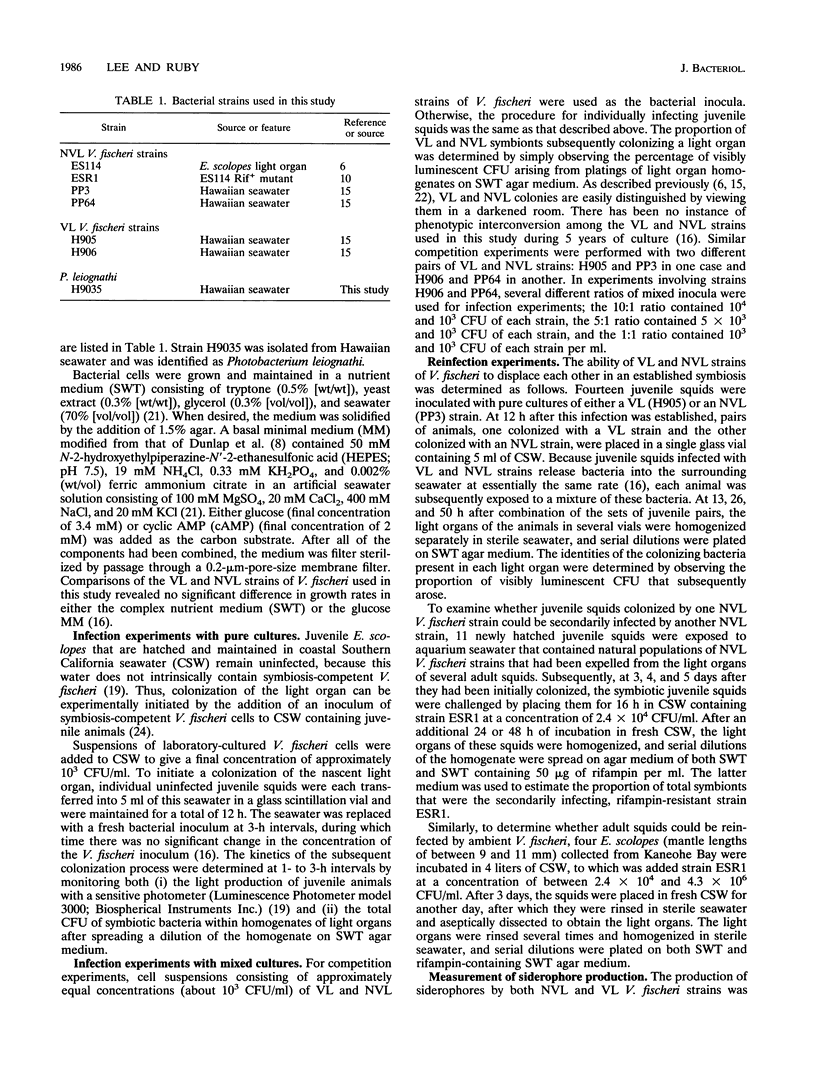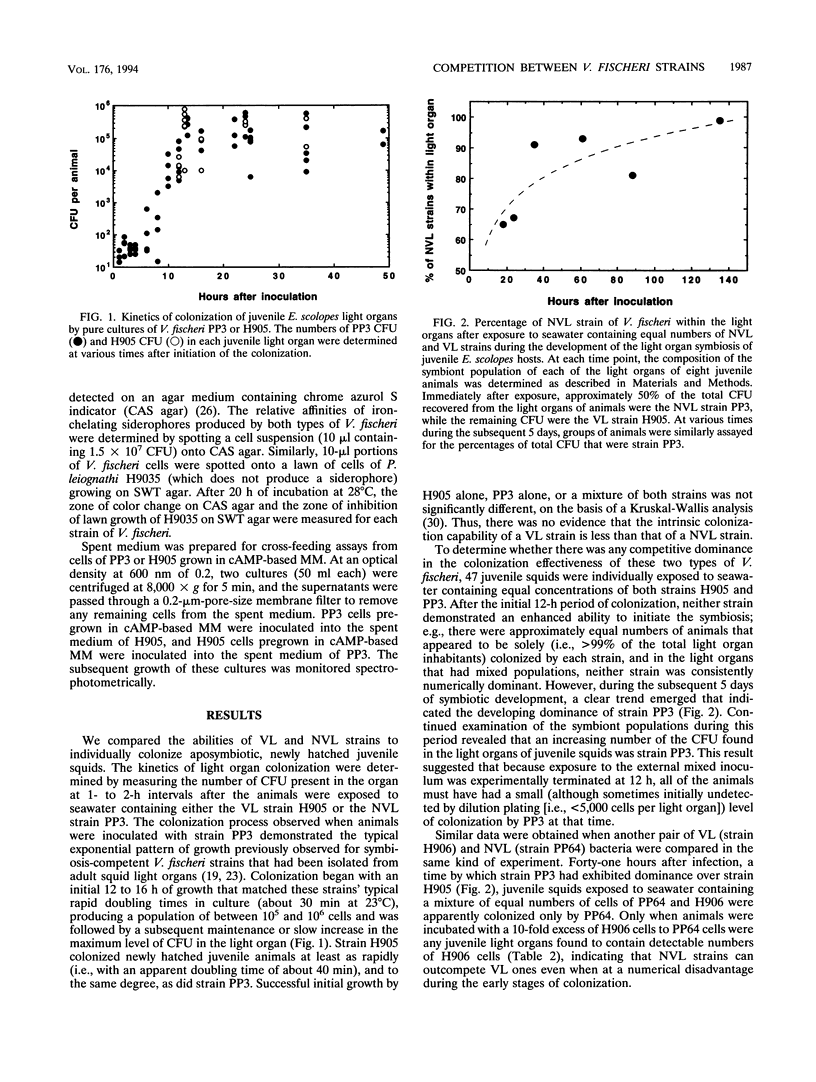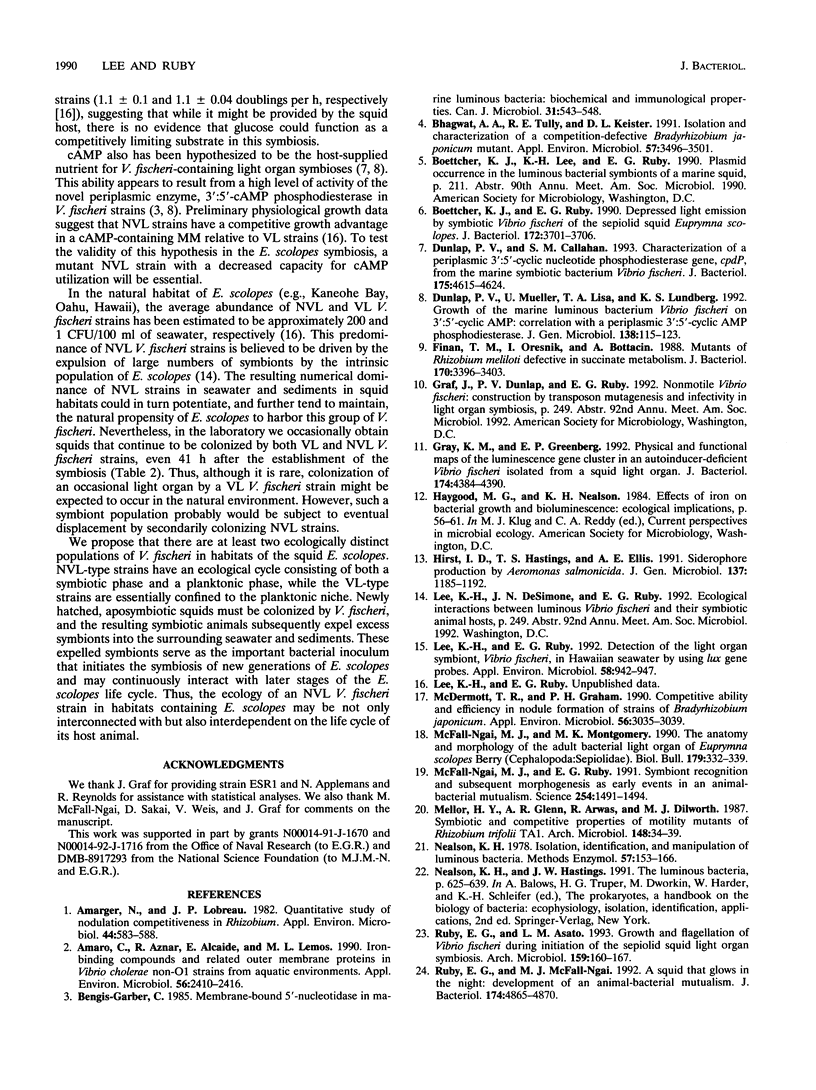Abstract
Colonization of the light-emitting organ of the Hawaiian squid Euprymna scolopes is initiated when the nascent organ of a newly hatched squid becomes inoculated with Vibrio fischeri cells present in the ambient seawater. Although they are induced for luminescence in the light organ, these symbiotic strains are characteristically non-visibly luminous (NVL) when grown in laboratory culture. The more typical visibly luminous (VL) type of V. fischeri co-occurs in Hawaiian seawater with these NVL strains; thus, two phenotypically distinct groups of this species potentially have access to the symbiotic niche, yet only the NVL ones are found there. In laboratory inoculation experiments, VL strains, when presented in pure culture, showed the same capability for colonizing the light organ as NVL strains. However, in experiments with mixed cultures composed of both VL and NVL strains, the VL ones were unable to compete with the NVL ones and did not persist within the light organ as the symbiosis became established. In addition, NVL strains entered light organs that had already been colonized by VL strains and displaced them. The mechanism underlying the symbiotic competitiveness exhibited by NVL strains remains unknown; however, it does not appear to be due to a higher potential for siderophore activity. While a difference in luminescence phenotype between VL and NVL strains in culture is not likely to be significant in the symbiosis, it has helped identify two distinct groups of V. fischeri that express different colonization capabilities in the squid light organ. This competitive difference provides a useful indication of important traits in light organ colonization.
Full text
PDF






Selected References
These references are in PubMed. This may not be the complete list of references from this article.
- Amarger N., Lobreau J. P. Quantitative study of nodulation competitiveness in Rhizobium strains. Appl Environ Microbiol. 1982 Sep;44(3):583–588. doi: 10.1128/aem.44.3.583-588.1982. [DOI] [PMC free article] [PubMed] [Google Scholar]
- Amaro C., Aznar R., Alcaide E., Lemos M. L. Iron-binding compounds and related outer membrane proteins in Vibrio cholerae non-O1 strains from aquatic environments. Appl Environ Microbiol. 1990 Aug;56(8):2410–2416. doi: 10.1128/aem.56.8.2410-2416.1990. [DOI] [PMC free article] [PubMed] [Google Scholar]
- Bengis-Garber C. Membrane-bound 5'-nucleotidase in marine luminous bacteria: biochemical and immunological properties. Can J Microbiol. 1985 Jun;31(6):543–548. doi: 10.1139/m85-101. [DOI] [PubMed] [Google Scholar]
- Bhagwat A. A., Tully R. E., Keister D. L. Isolation and Characterization of a Competition-Defective Bradyrhizobium japonicum Mutant. Appl Environ Microbiol. 1991 Dec;57(12):3496–3501. doi: 10.1128/aem.57.12.3496-3501.1991. [DOI] [PMC free article] [PubMed] [Google Scholar]
- Boettcher K. J., Ruby E. G. Depressed light emission by symbiotic Vibrio fischeri of the sepiolid squid Euprymna scolopes. J Bacteriol. 1990 Jul;172(7):3701–3706. doi: 10.1128/jb.172.7.3701-3706.1990. [DOI] [PMC free article] [PubMed] [Google Scholar]
- Dunlap P. V., Callahan S. M. Characterization of a periplasmic 3':5'-cyclic nucleotide phosphodiesterase gene, cpdP, from the marine symbiotic bacterium Vibrio fischeri. J Bacteriol. 1993 Aug;175(15):4615–4624. doi: 10.1128/jb.175.15.4615-4624.1993. [DOI] [PMC free article] [PubMed] [Google Scholar]
- Finan T. M., Oresnik I., Bottacin A. Mutants of Rhizobium meliloti defective in succinate metabolism. J Bacteriol. 1988 Aug;170(8):3396–3403. doi: 10.1128/jb.170.8.3396-3403.1988. [DOI] [PMC free article] [PubMed] [Google Scholar]
- Gray K. M., Greenberg E. P. Physical and functional maps of the luminescence gene cluster in an autoinducer-deficient Vibrio fischeri strain isolated from a squid light organ. J Bacteriol. 1992 Jul;174(13):4384–4390. doi: 10.1128/jb.174.13.4384-4390.1992. [DOI] [PMC free article] [PubMed] [Google Scholar]
- Hirst I. D., Hastings T. S., Ellis A. E. Siderophore production by Aeromonas salmonicida. J Gen Microbiol. 1991 May;137(5):1185–1192. doi: 10.1099/00221287-137-5-1185. [DOI] [PubMed] [Google Scholar]
- Lee K. H., Ruby E. G. Detection of the Light Organ Symbiont, Vibrio fischeri, in Hawaiian Seawater by Using lux Gene Probes. Appl Environ Microbiol. 1992 Mar;58(3):942–947. doi: 10.1128/aem.58.3.942-947.1992. [DOI] [PMC free article] [PubMed] [Google Scholar]
- McDermoti T. R., Graham P. H. Competitive Ability and Efficiency in Nodule Formation of Strains of Bradyrhizobium japonicum. Appl Environ Microbiol. 1990 Oct;56(10):3035–3039. doi: 10.1128/aem.56.10.3035-3039.1990. [DOI] [PMC free article] [PubMed] [Google Scholar]
- McFall-Ngai M. J., Ruby E. G. Symbiont recognition and subsequent morphogenesis as early events in an animal-bacterial mutualism. Science. 1991 Dec 6;254(5037):1491–1494. doi: 10.1126/science.1962208. [DOI] [PubMed] [Google Scholar]
- Ruby E. G., Asato L. M. Growth and flagellation of Vibrio fischeri during initiation of the sepiolid squid light organ symbiosis. Arch Microbiol. 1993;159(2):160–167. doi: 10.1007/BF00250277. [DOI] [PubMed] [Google Scholar]
- Ruby E. G., McFall-Ngai M. J. A squid that glows in the night: development of an animal-bacterial mutualism. J Bacteriol. 1992 Aug;174(15):4865–4870. doi: 10.1128/jb.174.15.4865-4870.1992. [DOI] [PMC free article] [PubMed] [Google Scholar]
- Ruby E. G., Nealson K. H. Symbiotic association of Photobacterium fischeri with the marine luminous fish Monocentris japonica; a model of symbiosis based on bacterial studies. Biol Bull. 1976 Dec;151(3):574–586. doi: 10.2307/1540507. [DOI] [PubMed] [Google Scholar]
- Schwyn B., Neilands J. B. Universal chemical assay for the detection and determination of siderophores. Anal Biochem. 1987 Jan;160(1):47–56. doi: 10.1016/0003-2697(87)90612-9. [DOI] [PubMed] [Google Scholar]
- Sharma S. B., Signer E. R. Temporal and spatial regulation of the symbiotic genes of Rhizobium meliloti in planta revealed by transposon Tn5-gusA. Genes Dev. 1990 Mar;4(3):344–356. doi: 10.1101/gad.4.3.344. [DOI] [PubMed] [Google Scholar]
- Simpson L. M., Oliver J. D. Siderophore production by Vibrio vulnificus. Infect Immun. 1983 Aug;41(2):644–649. doi: 10.1128/iai.41.2.644-649.1983. [DOI] [PMC free article] [PubMed] [Google Scholar]
- Triplett E. W., Barta T. M. Trifolitoxin Production and Nodulation Are Necessary for the Expression of Superior Nodulation Competitiveness by Rhizobium leguminosarum bv. trifolii Strain T24 on Clover. Plant Physiol. 1987 Oct;85(2):335–342. doi: 10.1104/pp.85.2.335. [DOI] [PMC free article] [PubMed] [Google Scholar]
- Triplett E. W., Sadowsky M. J. Genetics of competition for nodulation of legumes. Annu Rev Microbiol. 1992;46:399–428. doi: 10.1146/annurev.mi.46.100192.002151. [DOI] [PubMed] [Google Scholar]


